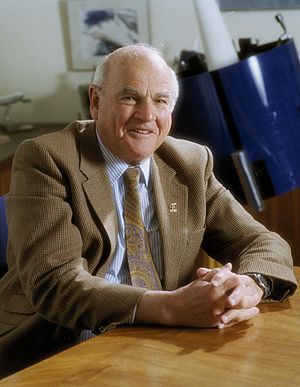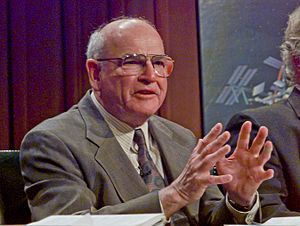Baruch Samuel Blumberg facts for kids
Quick facts for kids
Baruch Samuel Blumberg
|
|
|---|---|

Blumberg in 1999
|
|
| Born | July 28, 1925 Brooklyn, New York City, U.S.
|
| Died | April 5, 2011 (aged 85) |
| Alma mater | |
| Known for | Hepatitis B vaccine |
| Spouse(s) |
Jean Liebesman
(m. 1954) |
| Children | 4 |
| Awards | Nobel Prize in Medicine (1976) |
| Scientific career | |
| Fields | Biochemistry, physiology |
| Institutions |
|
|
Pennsylvania Historical Marker
|
|
| Official name | Baruch S. Blumberg (1925–2001) |
| Designated | September 24, 2016 |
Baruch Samuel Blumberg (July 28, 1925 – April 5, 2011), also known as Barry Blumberg, was an American doctor and geneticist. He won the 1976 Nobel Prize in Physiology or Medicine for his important work on the hepatitis B virus. He also helped create a test and a vaccine for this virus.
Blumberg and his colleague, Daniel Carleton Gajdusek, received the Nobel Prize for finding "new ways diseases spread and how they start." Blumberg's discovery of the hepatitis B virus and the vaccine has saved many lives around the world.
About Baruch Blumberg
Early Life and School
Baruch Blumberg was born in Brooklyn, New York, on July 28, 1925. His father, Meyer Blumberg, was a lawyer. As a child, he went to the Yeshivah of Flatbush where he learned Hebrew and studied the Bible. Another Nobel Prize winner, Eric Kandel, also went to this school at the same time.
Blumberg later attended James Madison High School and Far Rockaway High School. These schools were known for their high academic standards. Two other Nobel laureates, Burton Richter and Richard Feynman, also went to Far Rockaway High School.
During World War II, Blumberg served as a deck officer in the U.S. Navy. After the war, he went to Union College in Schenectady, New York, graduating in 1946.
He first studied mathematics at Columbia University. But he soon switched to medicine. He earned his medical degree (MD) from Columbia University's College of Physicians and Surgeons in 1951. He then worked at Columbia Presbyterian Medical Center for four years. Later, he went to the University of Oxford in England. There, he earned another degree (DPhil) in biochemistry in 1957. He later became the first American to lead Balliol College, Oxford, one of Oxford's colleges.
His Scientific Work
In the 1950s, Blumberg traveled the world. He collected human blood samples to study how people's genes are different. He wanted to understand why some people get sick from certain diseases while others don't.
In 1964, he was studying "yellow jaundice," which is now known as hepatitis. He found a special marker for hepatitis B in the blood of an Australian aborigine. This marker was first called the 'Australian antigen'. His research later showed that this virus could cause liver cancer.
Blumberg and his team then created a test to find the hepatitis B virus in blood. This helped stop the virus from spreading through blood donations. Most importantly, they developed a vaccine to prevent the disease. Blumberg shared his vaccine discovery freely. This helped drug companies make it available to many people. Thanks to the vaccine, the number of children with hepatitis B in China dropped a lot, from 15% to just 1% in ten years!
In 1964, Blumberg joined the Institute of Cancer Research in Philadelphia. This institute later became part of the Fox Chase Cancer Center in 1974. He also became a professor at the University of Pennsylvania in 1977. From 1989 to 1994, he was the Master of Balliol College.
From 1999 to 2002, he led the NASA Astrobiology Institute. This institute studies life in the universe. In 1992, Blumberg helped start the Hepatitis B Foundation. This group works to find a cure for hepatitis B and help those affected by it. He stayed involved with the foundation until he passed away.
In 2001, Blumberg joined the Library of Congress Scholars Council. This group advises the Librarian of Congress. He served on this council until his death.
From 2005, Blumberg was also the president of the American Philosophical Society. This is a very old and respected group of thinkers and scientists.
In 2010, Blumberg met with middle and high school students. He participated in a program called "Lunch with a Laureate" at the USA Science and Engineering Festival. Students could talk informally with a Nobel Prize winner.
Blumberg once said that saving lives was what drew him to medicine. He believed that "if you save a single life, you save the whole world." He often gave credit to the mental discipline he learned from studying the Jewish Talmud. He attended weekly Talmud discussion classes throughout his life.
His Passing
Baruch Blumberg passed away on April 5, 2011. He died shortly after giving a speech at a workshop at NASA Ames Research Center. At the time, he was a scientist at the NASA Lunar Science Institute.
Jonathan Chernoff, a director at the Fox Chase Cancer Center, said that Blumberg "prevented more cancer deaths than any person who's ever lived." Daniel Goldin, a former NASA administrator, said that "Our planet is an improved place as a result of Barry's few short days in residence."
After his death, the Library of Congress and National Aeronautics and Space Administration created a special research position in his honor. It is called the Baruch S. Blumberg NASA/Library of Congress Chair in Astrobiology. This position explores how astrobiology research affects society. Oxford University also created the Baruch Blumberg Professorship in Virology in his honor.
See also
 In Spanish: Baruch Samuel Blumberg para niños
In Spanish: Baruch Samuel Blumberg para niños
- List of Jewish Nobel laureates


